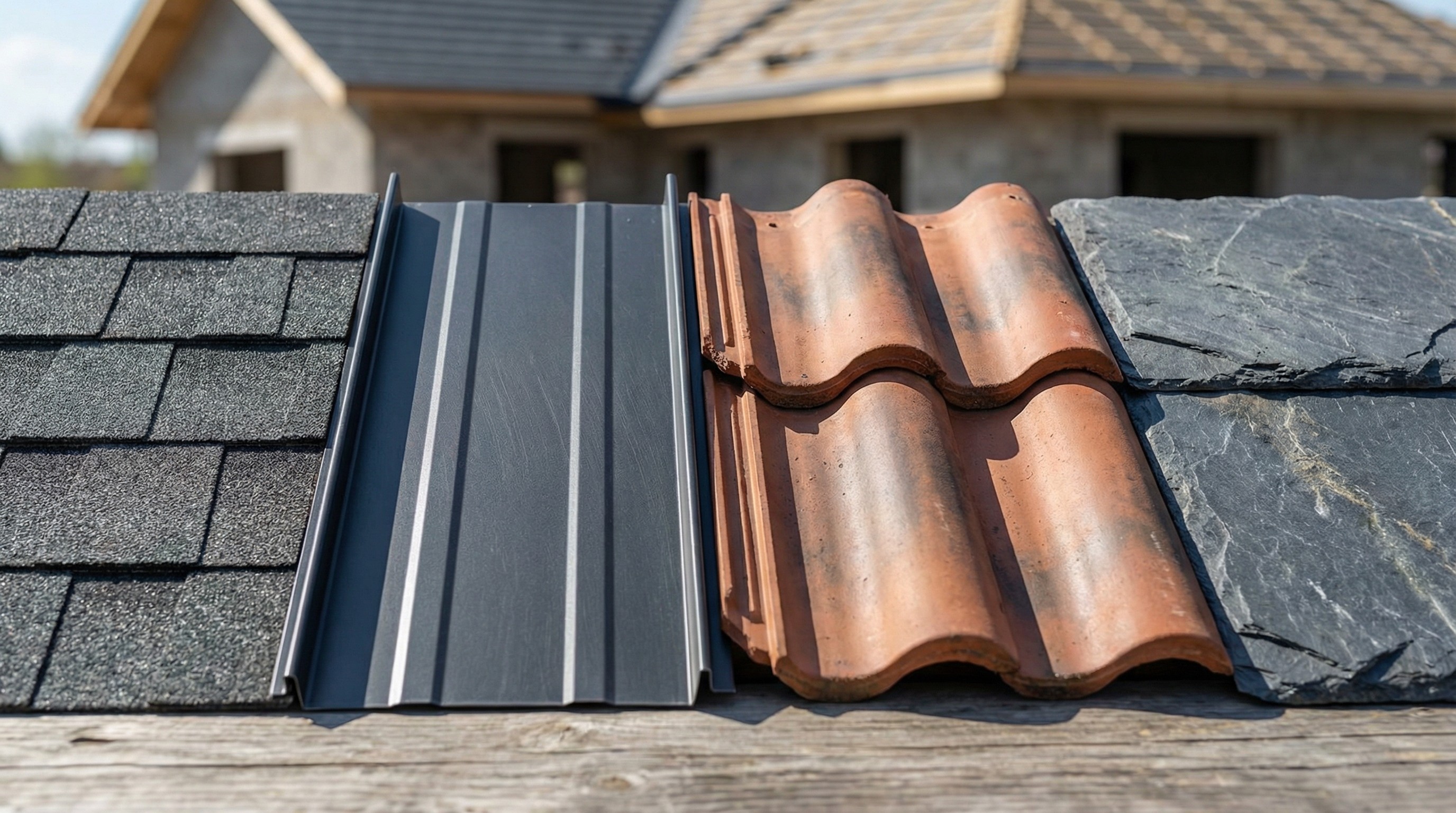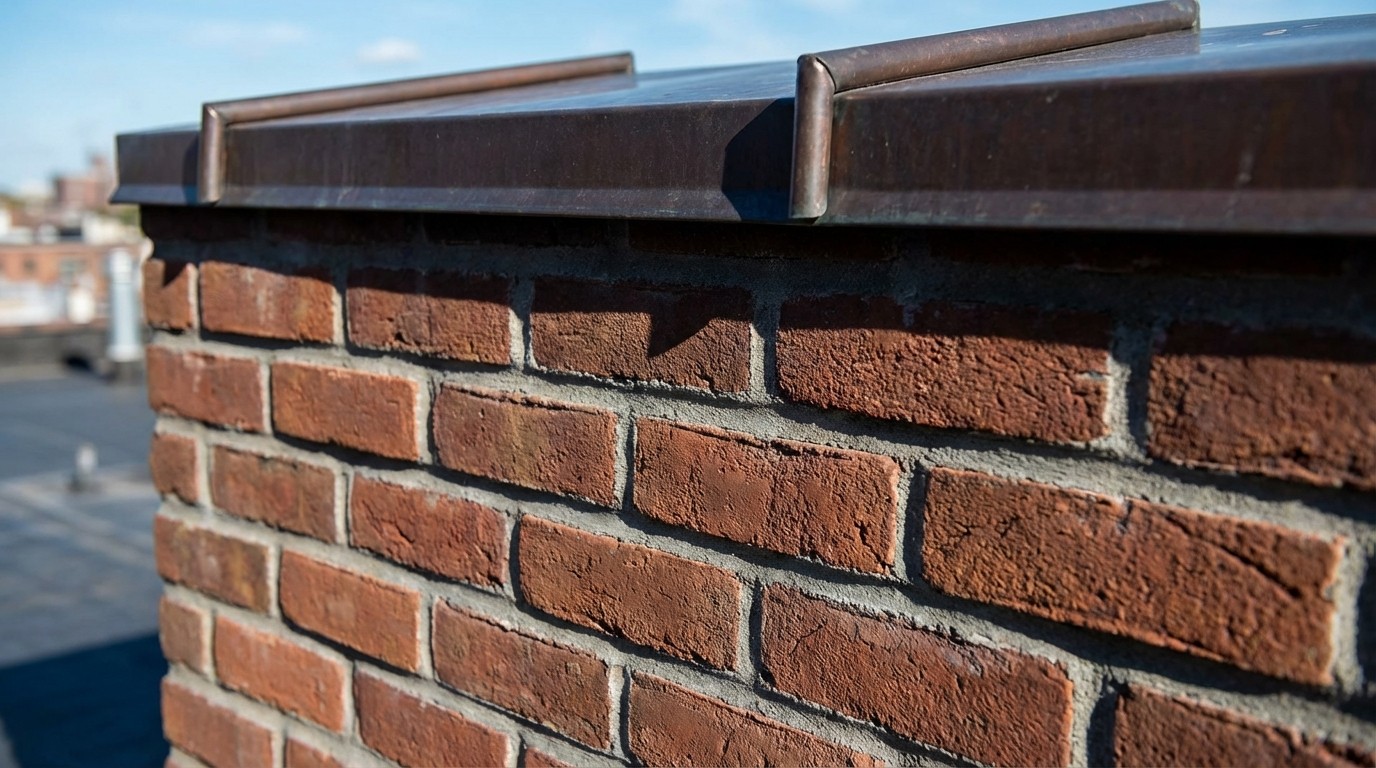Choosing a roofing material can be confusing when different contractors recommend different things. Let’s break it down. Each material has pros and cons. You just need to know what fits your budget, climate, and style best.
This guide breaks down the most common roofing materials, compares their costs and lifespans, and helps you figure out which one makes the most sense for your home.
What Is the Best Roofing Material for Most Homes
For most homeowners, asphalt shingles offer the best balance of affordability and performance. However, the right roofing material still depends on your climate, budget, and style.
Here is how to think about it based on your priorities:
Budget-focused: Asphalt shingles are the most affordable and widely installed roofing material in the country, especially 3-tab asphalt shingles, which offer the lowest upfront cost for homeowners on a tight budget.
Durability-focused: Metal roofing resists fire, wind, and impact better than most alternatives.
Longevity-focused: Slate and tile roofs last the longest but come with higher costs and weight.
Climate-focused: Hot climates favor reflective materials like metal and tile. Cold climates do well with metal and slate, which shed snow easily.
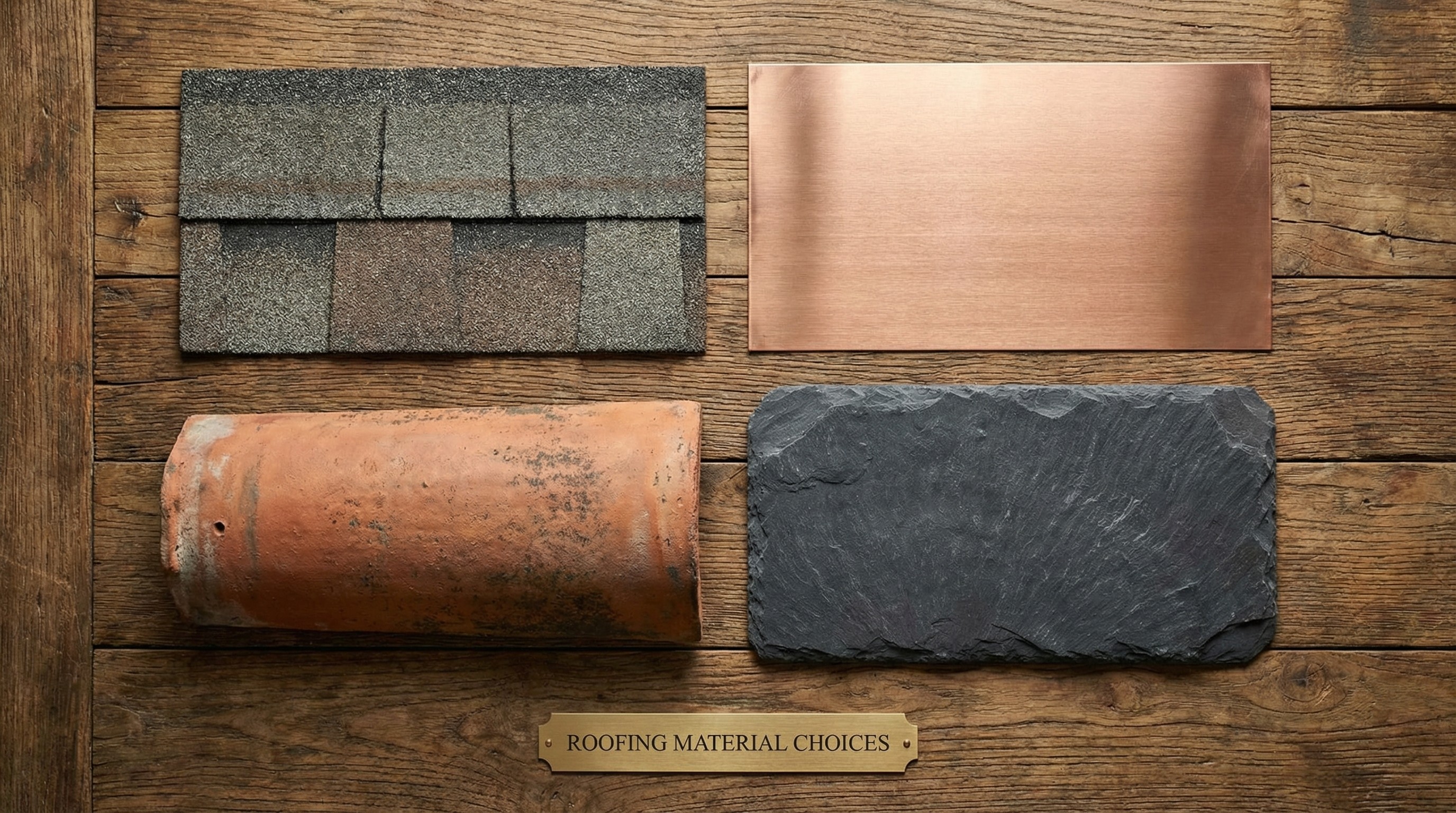
Roof Material Types at a Glance
Before getting into the details, here is a quick comparison of the most common roofing materials. This table gives you a sense of how they stack up against each other.
Table data and material lifespans are based on guidelines from NRCA and ICC-certified sources.
Material | Typical Lifespan | Relative Cost | Best For |
|---|---|---|---|
Asphalt Shingles | 15-30 years | Low | Budget-conscious homeowners |
Metal Roofing | 40-70+ years | Medium to High | Durability and energy efficiency |
Clay/Concrete Tile | 50-100+ years | High | Hot climates and curb appeal |
Slate | 75-150+ years | Highest | Historic homes and maximum longevity |
Wood Shakes | 20-40 years | Medium | Natural aesthetics |
Composite/Synthetic | 30-50 years | Medium | Versatility and lower maintenance |
Asphalt Shingles
Asphalt shingles are the most common roofing material in America. They work on most roof slopes, come in dozens of colors, and are relatively easy to install. There are three main types, each with different performance levels and price points.
3-Tab Shingles
3-tab shingles are the most basic asphalt option. They have a flat, uniform look with a single layer of material. While they are the least expensive choice, they also have the shortest lifespan of any asphalt shingle. For homeowners on a tight budget or those roofing a rental property, 3-tab shingles provide basic protection at the lowest cost point.
Architectural Shingles
Architectural shingles (also called dimensional shingles) are thicker than 3-tab shingles. After this first mention, we will use "architectural shingles" throughout. They have a layered, textured appearance that adds visual depth to a roof. Beyond looks, they also offer better wind and impact resistance. For homeowners who want a balance of cost and quality, architectural shingles are the most popular choice.
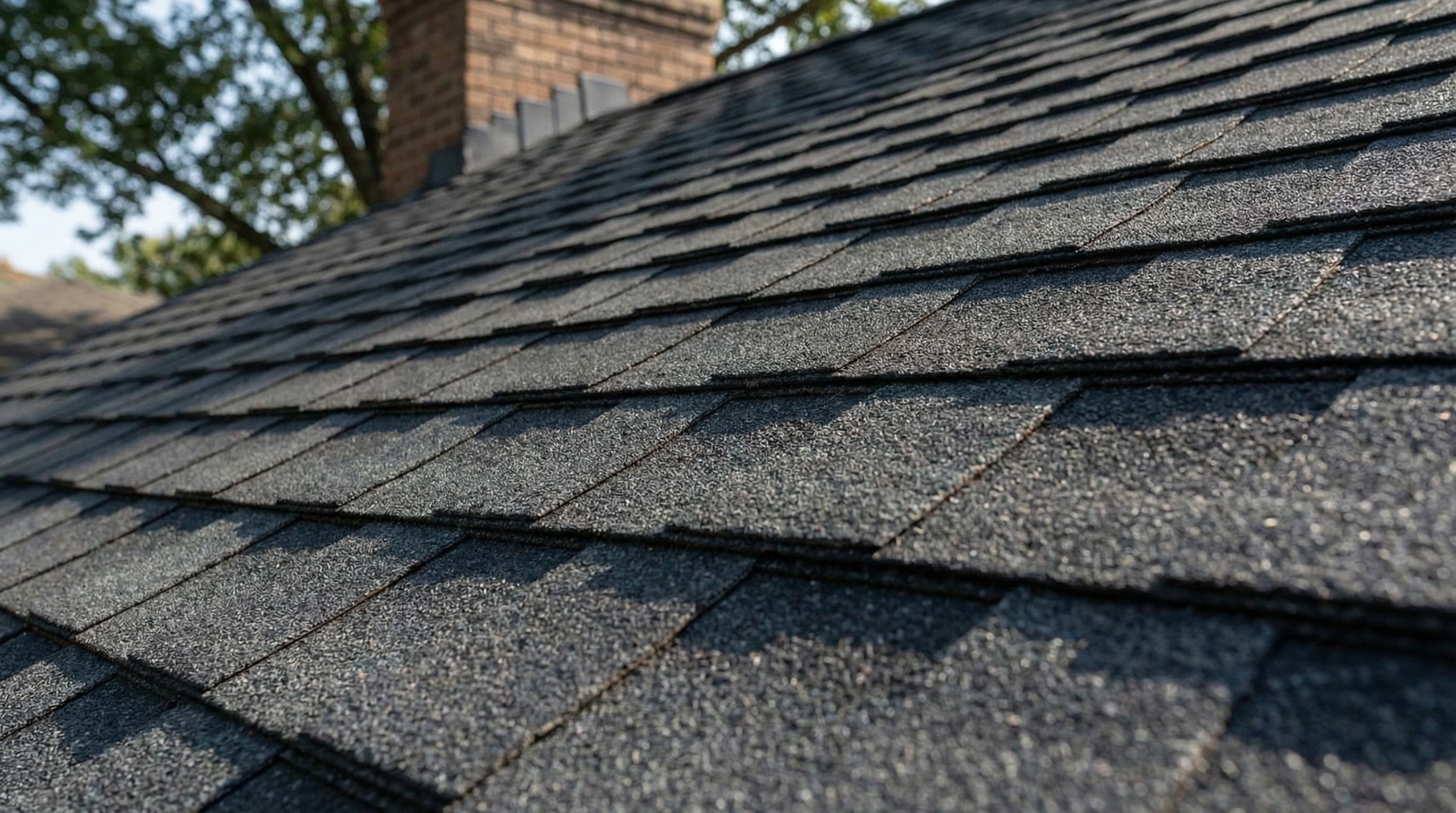
Designer Shingles
Designer shingles are premium asphalt shingles that look like slate or wood shakes. They are the heaviest and most durable asphalt option. They cost more than standard shingles. However, they are still much less expensive than natural slate or real wood.
Metal Roofing
Metal roofing has become increasingly popular because it lasts a long time and handles extreme weather well. Some homeowners worry about noise during rainstorms. In reality, modern metal roofs often include insulation or underlayment that reduces noise significantly.
Standing Seam Metal Roofs
Standing seam roofs feature vertical panels with raised seams that interlock. Because there are no exposed fasteners, the risk of leaks drops significantly. The look is sleek and modern. Standing seam roofs cost more upfront, but they tend to last longer and require less maintenance than other metal options.
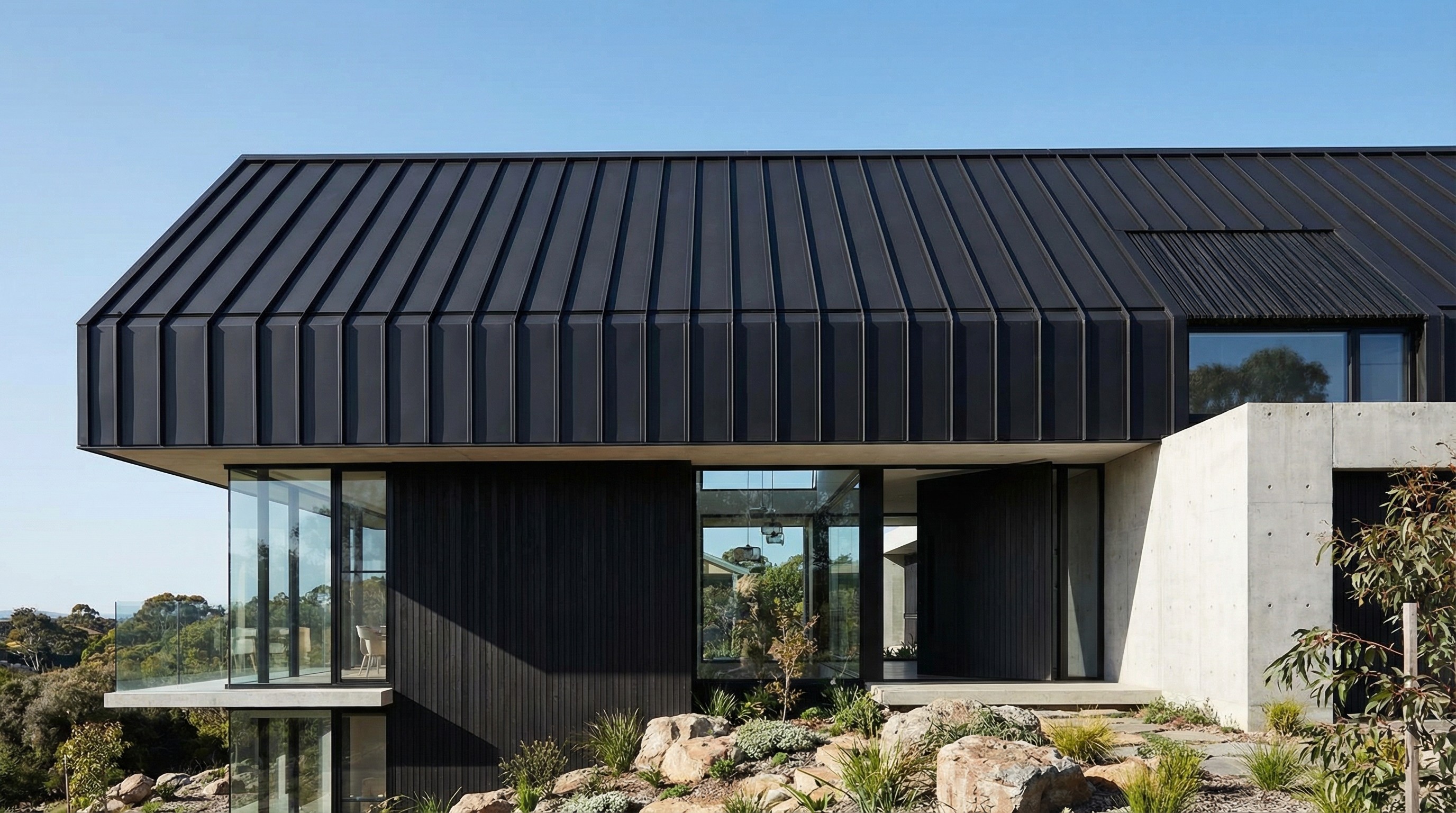
Metal Shingles and Panels
Metal can also be formed to look like traditional shingles, tiles, or wood shakes. This gives you the durability of metal with a more familiar appearance. If your neighborhood has strict style guidelines or your HOA limits roofing options, metal shingles often satisfy the requirements while still delivering strong performance.
Stone-Coated Steel
Stone-coated steel panels are covered with stone granules that give them a textured look similar to asphalt or tile. You get the strength of metal with better curb appeal for neighborhoods where a traditional appearance matters.
Tile Roofing
Tile roofing works especially well in hot climates. The material absorbs heat slowly and releases it slowly, which helps regulate indoor temperatures. However, tile is heavy. Some homes may require structural reinforcement before installation, so it is worth checking with a contractor early in the process.
Clay Tiles
Clay tiles have been used for roofing for centuries. They perform exceptionally well in hot climates because they resist heat and sun damage. Each tile is shaped like a half-cylinder, which people often call a “barrel” design. This shape helps channel water and provides excellent durability.
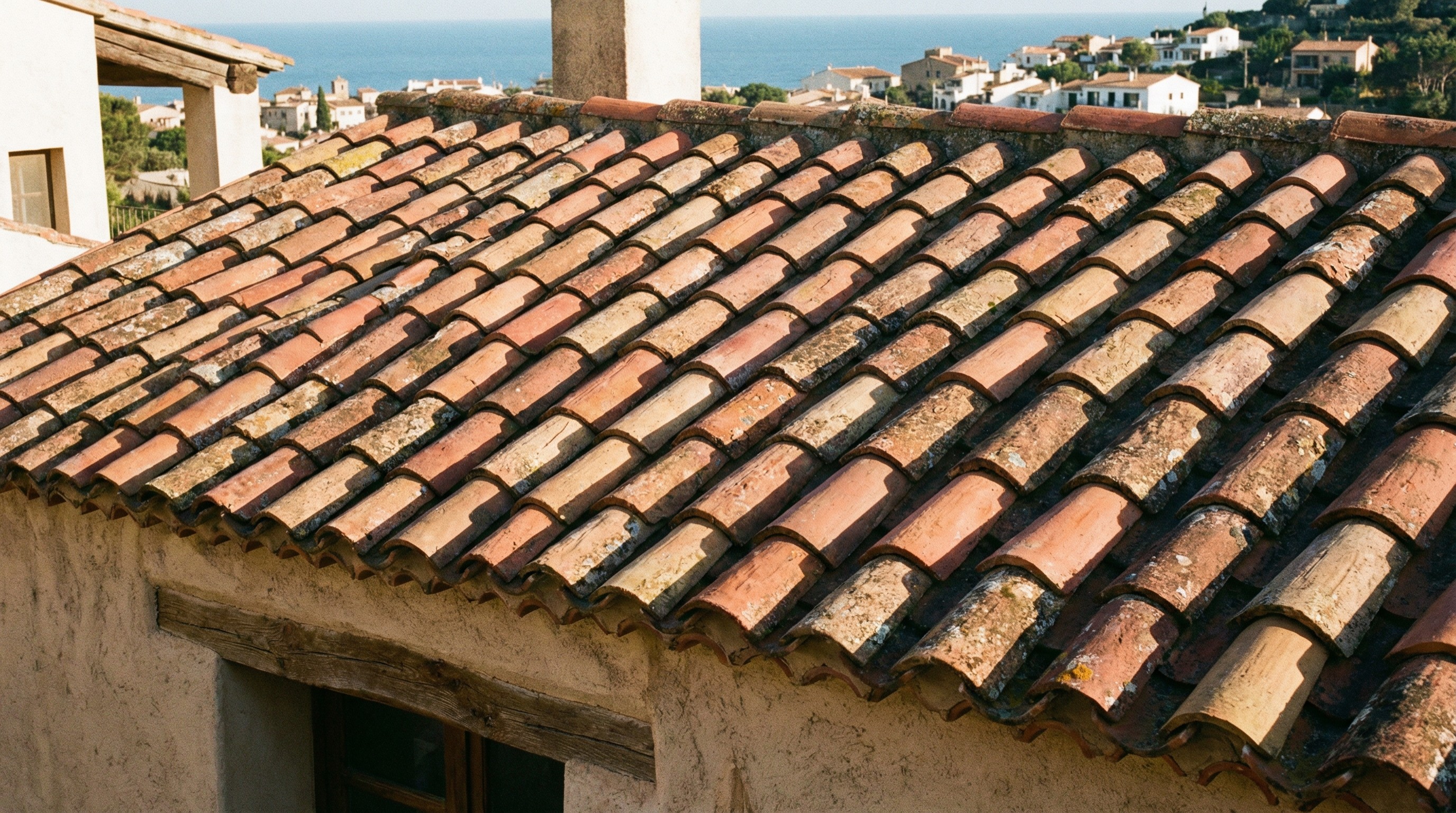
Concrete Tiles
Concrete tiles offer similar benefits to clay at a lower price. They are heavier than clay and available in many shapes and colors. Concrete can mimic the look of clay, slate, or wood, which gives you flexibility in appearance without the higher cost of natural materials.
Slate Roofing
Slate is the longest-lasting roofing material available. A properly installed slate roof can protect a home for well over a century. However, slate is also the heaviest and most expensive option. Installation requires specialized experience, and not every roofing contractor has it.
Both NRCA and ANSI provide best-practice guidelines for slate installation and maintenance.
Natural Slate
A slate roof can add substantial curb appeal and typically increases a home's resale value, though the high upfront cost means you may not recoup the full investment unless you stay in the home long-term.
Synthetic Slate
Synthetic slate is manufactured from rubber, plastic, or composite materials. It looks like natural slate but weighs far less and costs significantly less. Installation is easier, making synthetic slate a good option for homeowners who want the slate look without the structural requirements or premium price tag.
Wood Shingles and Shakes
Wood shingles are machine-cut and smooth. Wood shakes are hand-split and have a rougher, more textured appearance. Both weather to a natural gray over time and give homes a distinctive, rustic look.
Important: Check your local building codes before choosing wood roofing. Some areas have restrictions due to higher fire risk. Ask your roofer about any special treatments or permits needed. This ensures you comply with safety regulations.
Composite and Synthetic Roofing Materials
Composite and synthetic roofing materials are engineered to replicate the look of slate, wood, or tile without the drawbacks. Many are made from recycled materials. They are generally lighter and require less maintenance than the natural products they imitate. Impact-resistant versions are available for areas prone to hail.
How to Choose the Best Roof Material for Your BudgetIn short: The best value for most homeowners is architectural asphalt shingles, but your budget and goals may point you to metal, slate, or tile-factor in both upfront and long-term costs.
Upfront cost is only part of the picture. A roof that costs more initially but lasts twice as long may actually cost less per year of use. When comparing options, it helps to factor in expected lifespan, maintenance, and potential energy savings.
Lowest upfront cost: 3-tab asphalt shingles
Best value for most homes: Architectural asphalt shingles
Higher upfront, lower long-term cost: Metal roofing costs more at first but often saves money over time thanks to its long lifespan and lower maintenance needs.
Premium investment: Slate or tile for maximum longevity
How Climate Affects Your Roof Material Choice
Climate considerations for roofing materials include:
Hot climates: Metal, clay tile, and concrete tile reflect heat and reduce cooling costs. Light colors help even more.
Cold and snowy climates: Metal and slate shed snow well and resist ice damage. Steeper roof slopes also help.
Hail-prone areas: Impact-resistant shingles, metal, and synthetic materials hold up best.
Hurricane and high-wind zones: Metal roofing and architectural shingles with high wind ratings perform well.
Humid climates: Wood can rot in humid conditions unless treated. Metal and tile resist moisture damage.
Which Roofing Materials Last the Longest
Proper installation and regular maintenance affect how long any roof lasts. That said, here is how materials generally rank from longest to shortest lifespan:
Longest: Natural slate
Very long: Clay tile, concrete tile, metal roofing
Long: Synthetic slate, composite materials, premium asphalt
Moderate: Architectural asphalt shingles, wood shakes
Shorter: 3-tab asphalt shingles
How to Compare Roofing Quotes When Materials Differ
Comparing quotes for different materials is not straightforward. A higher price tag might actually be the better value over time. Here is what to look at:
Total installed cost: Materials plus labor together
Expected lifespan: Divide total cost by estimated years of service to get a cost-per-year figure
Underlayment and accessories: Better underlayment and flashing affect performance and warranty coverage
Maintenance requirements: Some materials require periodic treatment or inspection
Warranty coverage: Longer warranties often indicate better materials
What a Good Roofing Quote Should Include
A detailed quote helps you avoid surprise costs and compare contractors fairly. Vague quotes make it difficult to compare contractors fairly and may indicate incomplete planning. Here is what to look for:
Materials specified by brand and product name
Quantity of materials
Labor costs listed separately
Cost for removal and disposal of old roofing
Underlayment, flashing, and ventilation details
Permit fees if required
Timeline for completion
Warranty information for both materials and workmanship

